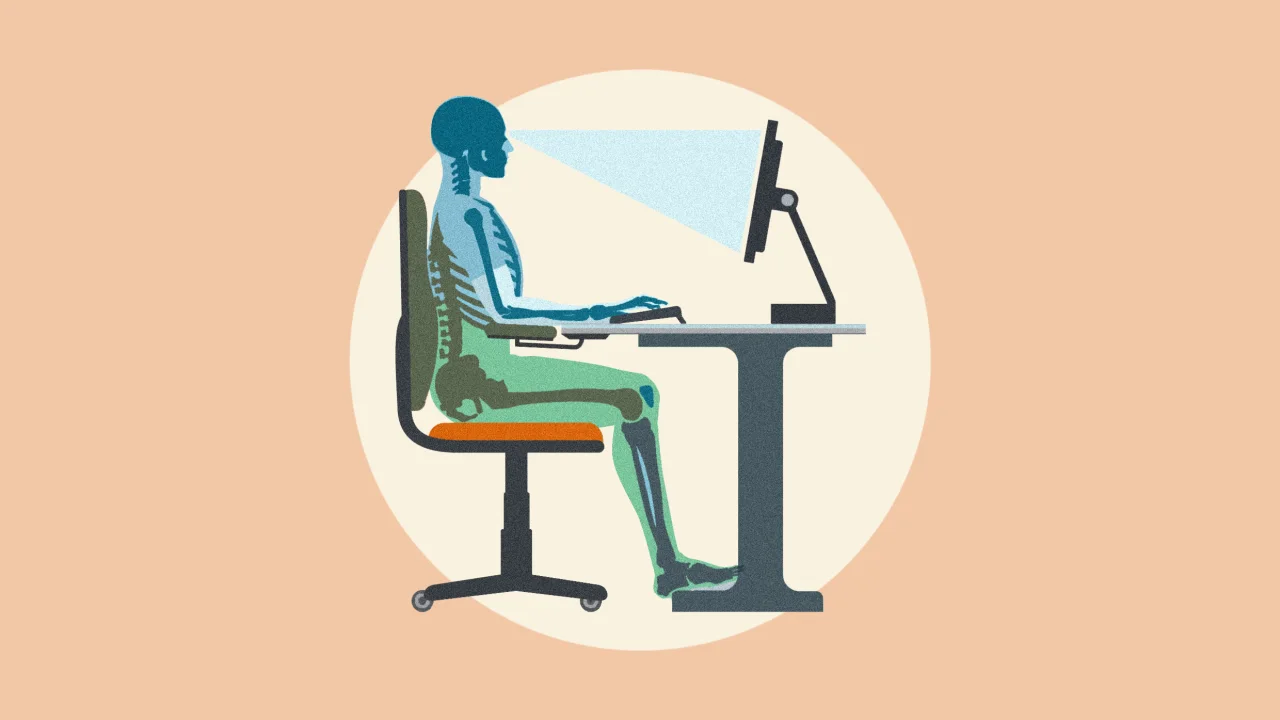5 things you’re getting wrong about sitting at your desk, according to an ergonomics expert
The likelihood that everyone in your office has the same shoe size is probably really low. Between differences in height, gender, and age, shoe sizes can vary widely. So when all of your officemates are using the same standard desks and chairs, it would track that a lot of people find that their work environment doesn’t quite fit right either. Compounding this problem is the fact that the average American spends approximately eight to nine hours a day sitting at work. No wonder 42% to 69% of office workers are estimated to have neck pain and 31% to 51% to have lower back pain. “Some of the main risk factors that are leading to those injuries are awkward and non-neutral postures,” says Lora Cavuoto, director of University at Buffalo’s Ergonomics and Biomechanics Lab. Luckily, learning some of the basics from the field of ergonomics can help you adjust your working environment and lower your risk of developing long-term injuries from sitting improperly at work. Here are some ways Cavuoto recommends adjusting your work environment: 1. Maintain a neutral position To begin assessing how ergonomically your office set up is, it’s important to begin by finding your body’s neutral position. When your body is in neutral posture, your joints are aligned and there is minimal stress on your muscles, tendons, bones, and nerves. When sitting at a desk, this means positioning yourself so that your feet are resting on the floor, you are sitting up straight with your head aligned with your shoulders and hips, your shoulders and neck are relaxed, and your elbows and knees are at 90 degrees. If your chair and desk do not comfortably allow you to maintain this position, you should consider making some adjustments. “Let’s say your table is too high, for example,” says Cavuoto. “Then, in order to rest your arms on the table, you’re winging your arms out so you’re needing to hold up the weight of your arms. All the muscles in your neck and your shoulders really need to engage to do that. Or if your chair is too high and your legs are hanging . . . then you might be putting pressure on the back of the knee, and that can lead to some stopping of blood flow down to the feet, causing your feet to fall asleep.” The solutions for these can be as simple as adjusting your chair height or adding a foot rest under your desk. “Adding a box under your desk so that you raise your feet to get your knees into a good position and rest your feet on the ground, or adding a riser to your monitor so that it’s in a good position for you to look comfortably” are low-budget ways that can make a big difference, says Cavuoto. It’s also important to consider how these adjustments may need to differ from day to day depending on what you are wearing and what tasks you are completing. “One thing we often forget is if you wear different shoes, you may need to adjust the height of your chair, or add or remove a foot rest,” Cavuoto says. “Even if you’re switching from using a keyboard to writing something on a piece of paper, you might need to adjust the chair a little bit so that your arms are in a better position, because . . . the keyboard has maybe an inch or 2 of elevation.” 2. Move your body regularly Even if you did maintain perfect neutral sitting posture throughout the workday, you might still encounter problems like blood pooling in parts of your body if you aren’t moving enough to circulate it. Additionally, sitting for long uninterrupted periods of time can lead to your blood sugar levels rising, causing the body to release insulin. Over time, as the body gets used to this, this could lead to inflammation and plaque buildup in your arteries. Cavuoto recommends getting up and taking regular movement breaks throughout the day to avoid these adverse effects. She also recommends paying special attention to areas of the body that tend to be under a lot of stress over the workday. “Doing regular wrist extensor and wrist flexor exercises are important to stretch those tendons and ligaments in the wrists” to reduce pain for people who spend a lot of time typing, she says. Similarly, she recommends taking a few moments throughout the day to stretch your neck. 3. Use a chair with proper back support Using chairs without good back support for long periods of time can put a lot of stress on your back and leg muscles to hold up your body. If you don’t have “fully fit core musculature, [and] you’re engaging those muscles all the time . . . those muscles can be tired,” causing you to slouch and put pressure on your spine and other muscles, Cavuoto says. If you’re able to choose your work chair, she recommends looking for one that can recline and has a headrest which allows you more flexibility to relieve pressure and adjust your body throughout the day. “That allows you to rest your neck, your head, and your shoulders . . . so you can offload that head weight right off your neck,” she says. 4. Consider

The likelihood that everyone in your office has the same shoe size is probably really low. Between differences in height, gender, and age, shoe sizes can vary widely. So when all of your officemates are using the same standard desks and chairs, it would track that a lot of people find that their work environment doesn’t quite fit right either.
Compounding this problem is the fact that the average American spends approximately eight to nine hours a day sitting at work. No wonder 42% to 69% of office workers are estimated to have neck pain and 31% to 51% to have lower back pain.
“Some of the main risk factors that are leading to those injuries are awkward and non-neutral postures,” says Lora Cavuoto, director of University at Buffalo’s Ergonomics and Biomechanics Lab.
Luckily, learning some of the basics from the field of ergonomics can help you adjust your working environment and lower your risk of developing long-term injuries from sitting improperly at work.
Here are some ways Cavuoto recommends adjusting your work environment:
1. Maintain a neutral position
To begin assessing how ergonomically your office set up is, it’s important to begin by finding your body’s neutral position. When your body is in neutral posture, your joints are aligned and there is minimal stress on your muscles, tendons, bones, and nerves.
When sitting at a desk, this means positioning yourself so that your feet are resting on the floor, you are sitting up straight with your head aligned with your shoulders and hips, your shoulders and neck are relaxed, and your elbows and knees are at 90 degrees.
If your chair and desk do not comfortably allow you to maintain this position, you should consider making some adjustments. “Let’s say your table is too high, for example,” says Cavuoto. “Then, in order to rest your arms on the table, you’re winging your arms out so you’re needing to hold up the weight of your arms. All the muscles in your neck and your shoulders really need to engage to do that. Or if your chair is too high and your legs are hanging . . . then you might be putting pressure on the back of the knee, and that can lead to some stopping of blood flow down to the feet, causing your feet to fall asleep.”
The solutions for these can be as simple as adjusting your chair height or adding a foot rest under your desk. “Adding a box under your desk so that you raise your feet to get your knees into a good position and rest your feet on the ground, or adding a riser to your monitor so that it’s in a good position for you to look comfortably” are low-budget ways that can make a big difference, says Cavuoto.
It’s also important to consider how these adjustments may need to differ from day to day depending on what you are wearing and what tasks you are completing. “One thing we often forget is if you wear different shoes, you may need to adjust the height of your chair, or add or remove a foot rest,” Cavuoto says. “Even if you’re switching from using a keyboard to writing something on a piece of paper, you might need to adjust the chair a little bit so that your arms are in a better position, because . . . the keyboard has maybe an inch or 2 of elevation.”
2. Move your body regularly
Even if you did maintain perfect neutral sitting posture throughout the workday, you might still encounter problems like blood pooling in parts of your body if you aren’t moving enough to circulate it. Additionally, sitting for long uninterrupted periods of time can lead to your blood sugar levels rising, causing the body to release insulin. Over time, as the body gets used to this, this could lead to inflammation and plaque buildup in your arteries.
Cavuoto recommends getting up and taking regular movement breaks throughout the day to avoid these adverse effects.
She also recommends paying special attention to areas of the body that tend to be under a lot of stress over the workday. “Doing regular wrist extensor and wrist flexor exercises are important to stretch those tendons and ligaments in the wrists” to reduce pain for people who spend a lot of time typing, she says. Similarly, she recommends taking a few moments throughout the day to stretch your neck.
3. Use a chair with proper back support
Using chairs without good back support for long periods of time can put a lot of stress on your back and leg muscles to hold up your body. If you don’t have “fully fit core musculature, [and] you’re engaging those muscles all the time . . . those muscles can be tired,” causing you to slouch and put pressure on your spine and other muscles, Cavuoto says.
If you’re able to choose your work chair, she recommends looking for one that can recline and has a headrest which allows you more flexibility to relieve pressure and adjust your body throughout the day. “That allows you to rest your neck, your head, and your shoulders . . . so you can offload that head weight right off your neck,” she says.
4. Consider your lighting environment
It’s important to note the impact that lighting has on our eyes throughout the day. Eye strain can cause a number of unpleasant effects, from migraines to neck and shoulder pain. While an office setting likely provides more even lighting conditions, Cavuoto says that a lot of people don’t think about light sources as much when working from home.
She recommends setting up your work environment with lighting that you can control over the day and to avoid settings that cause strong glare off your screen.
5. Use a monitor or a laptop screen, not both
“I don’t really use my laptop screen at all, actually,” says Cavuoto. While using an external monitor is helpful because it enlarges the screen, another “challenge when you’re using a laptop and an external monitor on a desk is that the laptop is down on the surface and the monitor is a little bit raised.”
Ideally, to maintain a neutral posture, your screen should be at eye level. But when switching between a laptop and monitor, you may experience some neck pain and eye strain from switching focus between two screens at different heights and scales. If you don’t have access to a monitor, try raising your laptop on a stand or stacking books underneath it to get it to eye level.





































































































































































































